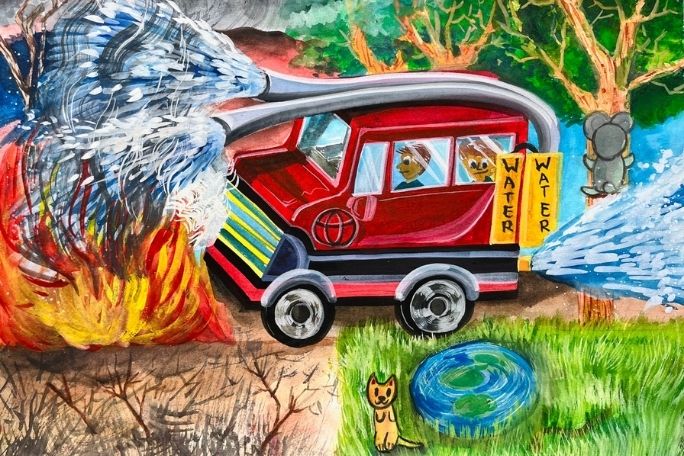Lesson summary
In this lesson, students design a dream car and create an artwork to represent their ideas that will be submitted to the Toyota Dream Car Art Contest. This contest encourages and inspires creative expression and imagination in students – some amazing ideas are born from dreams! Students will examine the winners of last year’s Toyota Dream Car Art Contest, analysing how well these cars meet the principles of sustainability, and evaluating the artistic messages and visual conventions displayed in these artworks. Students then work as a class to brainstorm some ideas for their own dream cars, and then work independently to create their own dream car artworks.
Learning intentions:
Students will...
- understand how artists communicate artistic intentions and recognise the artistic intentions they will use when creating their own artworks
- recognise the visual conventions used by artists and identify those they personally want to use
- understand the principles of sustainability and how they can be incorporated into the design of products
- understand the value of dreaming when designing and creating artworks
Success criteria:
Students can...
- analyse in intent of artworks and design projects, created by students their own age
- use elements of social, economic and environmental sustainability in a design project
- utilise artistic creativity in their design project
Lesson guides and printables
Lesson details
Curriculum mapping
Australian curriculum content descriptions:
Years 7 and 8 Visual Arts:
- Practise techniques and processes to enhance representation of ideas in their art-making (ACAVAM121)
- Analyse how artists use visual conventions in artworks (ACAVAR123)
Year 9 and 10 Visual Arts:
- Manipulate materials, techniques, technologies and processes to develop and represent their own artistic intentions (ACAVAM126)
- Plan and design artworks that represent artistic intention (ACAVAM128)
Years 7 and 8 Design and Technologies:
- Investigate the ways in which products, services and environments evolve locally, regionally and globally and how competing factors including social, ethical and sustainability considerations are prioritised in the development of technologies and designed solutions for preferred futures (ACTDEK029)
Years 9 and 10 Design and Technologies:
- Critically analyse factors, including social, ethical and sustainability considerations, that impact on designed solutions for global preferred futures and the complex design and production processes involved (ACTDEK040)
- Explain how products, services and environments evolve with consideration of preferred futures and the impact of emerging technologies on design decisions (ACTDEK041)
Syllabus outcomes: VAS4.5, VAS4.3, VAS5.6, VAS5.5, T4.1.2, T4.1.3, T4.4.1, T4.6.2, D&T5.3.1, D&T5.3.2, D&T5.2.1, D&T5.3.1, D&T5.3.2.
General capabilities: Critical and creative thinking.
Cross-curriculum priority: Sustainability OI.8, Ethical Understanding.
Relevant parts of Years 7 and 8 Visual Arts achievement standards: Students identify and analyse how other artists use visual conventions and viewpoints to communicate ideas and apply this knowledge in their art making. They demonstrate use of visual conventions, techniques and processes to communicate meaning in their artworks.
Relevant parts of Years 9 and 10 Visual Arts achievement standards: Students evaluate how representations communicate artistic intentions in artworks they make and view. They manipulate materials, techniques and processes to develop and refine techniques and processes to represent ideas and subject matter in their artworks.
Relevant parts of Years 7 and 8 Design and Technologies achievement standards: Students explain factors that influence the design of products, services and environments to meet present and future needs.
Relevant parts of Years 9 and 10 Design and Technologies achievement standards: Students identify the changes necessary to designed solutions to realise preferred futures they have described.
Time required: 120 mins +
Level of teacher scaffolding: High – oversee discussion and brainstorming. Assist students with creating artworks. Submit entry forms.
Resources required
- Student Worksheet – one copy per student OR computers/tablets to access the online worksheet
- Device capable of presenting a website to the class
- Paper measuring no larger than 400mm x 550 mm (15.7-21.7in.) or A3 in size
- Drawing materials, including but not limited to coloured pencils, pens/markers, crayons, paints, watercolour paints, etc
- Sticky notes
Skills
This lesson is designed to build students’ competencies in the following skills:
- Communication
- Collaboration
- Creativity
- Problem Solving
Additional Info
The Toyota Dream Car Art Contest usually commences late October to early November and concludes late to early March. Find up-to-date entry details, prizes and full terms and conditions here.


Welcome back!
Don't have an account yet?
Log in with:
By signing up to Cool.org you consent and agree to Cool's privacy policy to
store, manage and process your personal information. To read more, please see
our privacy policy here(Opens in new tab).
Create your free Cool.org account.
Many of our resources are free, with an option to upgrade to Cool+ for premium content.
Already have an account?
Sign up with:
By signing up to Cool.org you consent and agree to Cool's privacy policy to
store, manage and process your personal information. To read more, please see
our privacy policy here(Opens in new tab).